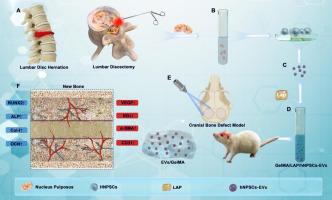Extracellular vesicles derived from nucleus pulposus mesenchymal stem cells combined with hydrogels promote bone defect repair
IF 5.1
3区 工程技术
Q1 CHEMISTRY, APPLIED
引用次数: 0
Abstract
In the case of large bone defects, the bone tissues cannot regenerate by themselves without extra surgical interventions. Recent studies showed that exosomes are a promising and relatively safe therapeutic tool for bone tissue engineering. Gelatin methacryloyl (GelMA)-based biomaterials can be used as a multifunctional matrix for bone tissue engineering scaffolds through various strategies to overcome major obstacles such as insufficient mechanical properties and uncontrollable degradation. Herein, we investigated the role and mechanism of human nucleus pulposus mesenchymal stem cells (hNPSCs) derived small extracellular vesicles (hNPSCs-EVs) on bone regeneration. EVs from the hNPSCs were initially extracted and identified. GelMA hydrogels were used to deliver hNPSCs-EVs, and the potential of hNPSCs-EVs in bone defect repair was investigated through in vivo and in vitro experiments on rat bone marrow-derived mesenchymal stem cells (BMSCs). In vitro results showed that hNPSCs-EVs offered substantial advantages in promoting BMSCs proliferation, migration, and angiogenesis. They significantly augmented the osteogenic ability of BMSCs by activating the mitogen-activated protein kinase signaling pathway, especially the extracellular regulated protein kinases 1/2 (ERK1/2) signaling pathway. In vivo results showed that hNPSCs-EVs containing GelMA hydrogel (hNPSCs-EVs/GelMA) effectively promoted bone regeneration. These results indicated that hNPSCs-EVs/GelMA offers a potential therapeutic option for bone defect management, and also provided valuable data for understanding the role and mechanism of hNPSCs-sEVs in bone regeneration.

髓核间充质干细胞衍生的细胞外囊泡与水凝胶结合可促进骨缺损修复
在较大骨缺损的情况下,如果没有额外的手术干预,骨组织不能自行再生。近年来的研究表明,外泌体是一种有前景且相对安全的骨组织工程治疗工具。明胶甲基丙烯酰(GelMA)基生物材料可以通过多种策略克服机械性能不足和不可控降解等主要障碍,作为骨组织工程支架的多功能基质。在此,我们研究了人髓核间充质干细胞(hNPSCs)衍生的细胞外小泡(hNPSCs- ev)在骨再生中的作用和机制。首先从hNPSCs中提取并鉴定电动汽车。采用GelMA水凝胶递送hnpscs - ev,并通过大鼠骨髓间充质干细胞(BMSCs)的体内和体外实验研究hnpscs - ev在骨缺损修复中的潜力。体外实验结果表明,hnpscs - ev在促进骨髓间充质干细胞增殖、迁移和血管生成方面具有显著优势。他们通过激活丝裂原激活的蛋白激酶信号通路,特别是细胞外调节蛋白激酶1/2 (ERK1/2)信号通路,显著增强了骨髓间充质干细胞的成骨能力。体内实验结果表明,含有GelMA水凝胶的hnpscs - ev (hnpscs - ev /GelMA)能有效促进骨再生。这些结果表明,hnpscs - ev /GelMA为骨缺损治疗提供了一种潜在的治疗选择,也为了解hnpscs - sev在骨再生中的作用和机制提供了有价值的数据。
本文章由计算机程序翻译,如有差异,请以英文原文为准。
求助全文
约1分钟内获得全文
求助全文
来源期刊

Reactive & Functional Polymers
工程技术-高分子科学
CiteScore
8.90
自引率
5.90%
发文量
259
审稿时长
27 days
期刊介绍:
Reactive & Functional Polymers provides a forum to disseminate original ideas, concepts and developments in the science and technology of polymers with functional groups, which impart specific chemical reactivity or physical, chemical, structural, biological, and pharmacological functionality. The scope covers organic polymers, acting for instance as reagents, catalysts, templates, ion-exchangers, selective sorbents, chelating or antimicrobial agents, drug carriers, sensors, membranes, and hydrogels. This also includes reactive cross-linkable prepolymers and high-performance thermosetting polymers, natural or degradable polymers, conducting polymers, and porous polymers.
Original research articles must contain thorough molecular and material characterization data on synthesis of the above polymers in combination with their applications. Applications include but are not limited to catalysis, water or effluent treatment, separations and recovery, electronics and information storage, energy conversion, encapsulation, or adhesion.
 求助内容:
求助内容: 应助结果提醒方式:
应助结果提醒方式:


